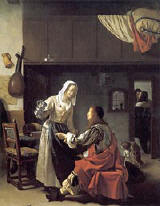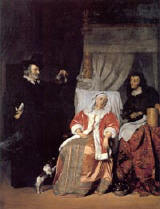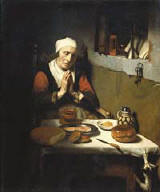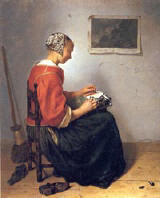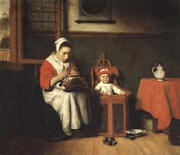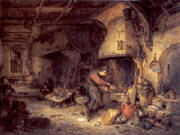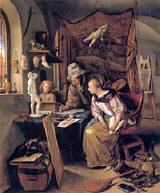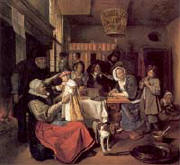The Subject Matter of Dutch Domestic Interiors

from:
Alejandro Vergara, "The Subject Matter of Paintings of Domestic Interiors"
in Vermeer and the Dutch Interior (Vermeer y El Interior Holandes)
2003
Within the context or European culture of the early modern period, the value of a work of art depended as much on its content as on the quality of its execution. The didactic and moral value of the great religious, historical and mythological subjects made these the most important within the hierarchy of the genres, ranking above others such as landscapes and portraits. It is difficult to over-emphasize the novelty of Dutch genre painting within this set of values: rather than the grandiose narratives derived from the classical tradition, a significant number of artists and collectors in the Netherlands during the 17th century opted for paintings which seemingly depicted nothing of great importance, but rather episodes from the daily lives of their contemporaries. A large part of the later success which such paintings enjoyed derives precisely from this apparent lack of interest in the subject-matter, which led 19th-century critics to conceive of Dutch genre painting as preoccupied not with content but with the manner in which it was represented, an honest and materialist art, which understood painting as an end in itself and not as a mere vehicle for emphasizing values from other realms of human thought.
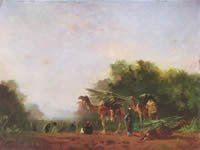
Arabs
Eugène Fromentin
1871
In our own times, this vision of Dutch painting has been rejected as inaccurate. It has not just exaggerated the difference between the Dutch and other artistic traditions without bearing in mind that the Netherlands also saw the production of large numbers of mythological and history paintings, but also the fact that genre painting (which mostly consisted of scenes of interiors) involves a thematic content which reflects the moral values of the society which produced it and contributed to its dissemination. As we will discuss, the debate as to how these paintings should be interpreted remains largely unresolved, but one can no longer maintain, as did the writer and French painter Eugène Fromentin (1820-1876), that the most surprising characteristic of Dutch painting is the absence of any significant content.
The main themes of Dutch interior paintings are those of love and the virtues of domestic life, and these are the focus of the present exhibition. The theme of love appears in a wide variety of ways, from romantic scenes of lovers separated by distance to scenes in brothels or of sexual love treated with a frankness that is also found in Dutch literature of the period. In Van Mieris' painting Tavern Scene (see right, a.), the presence of two mating dogs in the background leaves no doubt as to the type of business conducted between the couple seen through the doorway, or the type of amorous relationship between the two young people the foreground. Other scenes of elegant interiors that show women dressing and adorning themselves, and seemingly offering themselves to the spectator, should probably be understood in the same way. The theme of seduction does not necessarily imply a financial transaction, but a sexual relationship is certainly often implicit. In many of these paintings we see wine and musical instruments. In fact, alcohol is present in such quantities in scenes of seduction that it seems to have been normally associated with the subject of love. The relationship of music and love had long existed in art, for example in Titian's paintings of Venus with an organist (Museo del Prado), and the use of musical harmony as a metaphor for harmony between two people united by love was a common one. Paintings such as Atta Wrum Probant by Jan Steen use this metaphor to explain relationship between the figures that invites the spectator to unite with her in an amorous relationship.
Vermeer produced some of the most refined versions of this type of subject, for example, the Music Lesson (see right b.), painted around 1662- 1665. Here the couple who are the subject of the painting are undoubtedly involved in an amorous relationship, as suggested by the presence of the jug of wine on the table, the viol bow on the ground waiting for someone to pick it up and join the woman in a musical duet, and the gaze which the young woman directs towards the man. In the painting ,a Lady Standing at the Virginals by the same artist, the presence of a young woman in front of this instrument again suggests that the scene involves the subject of love, as confirmed by a painting of Cupid hanging on the far wall.
The practice of writing letters was very common in 17th-century Holland, one of the countries with the highest levels literacy of all Europe. Vermeer, Metsu (see right c., d.) and other artists painted letters (which are either being written or being read) in contexts which immediately make us think that they are love letters. These paintings are astonishing in their ability to place us in the space occupied by their protagonists. We feel like intruders watching a young man as he expresses his most intimate emotions to his beloved through a letter, or we share the anguish produced by the absence of a loved one. Another subject related to love which often appears in Dutch genre painting is the one known as the "doctor's visit". The figure of the false doctor was used in painting and literature of the time as a symbol of duplicity. Painters such as Steen--who produced more than forty works on this subject--Metsu (see right e.), Dou and Van Mieris among others used this figure to allude to the phenomenon of falling in love and its consequences in a humorous way. These are paintings that depict the doctor as an elderly and formally dressed man who attempts to discover what ails the young woman who is posed in a melancholy attitude and whose only sickness is love, possibly of a type that has led her to become pregnant.
While the appeal of paintings that deal with the subject of love lies in their powers of evocation or in the humorous situations which they gives rise to, the main merit of another of the most frequently represented subjects within the genre of interior painting, that the virtues of domestic life, lies in the force of its moral conviction. These are simple scenes which reflect the importance of the family in contemporary society and the cult of virtues of the domestic life. Pieter de Hooch and Nicolaes Maes most frequently depicted this type of subject, also painted by Ter Borch and Vermeer among numerous others. In paintings of themes of love, celebrations or some of the professions the aim of the image was admonitory. In domestic scenes, by contrast, the intention was almost always exemplary; these were representations of virtuous behavior which remind us that homes were not just physician places but also the centre of society's moral instruction.
As we mentioned above, the protagonists of most of these scenes are women of all ages who, by being located in the home, occupy the place which society considered appropriate to them, and behaved according to the models set out for each age and social situation. We see young women receiving moral and domestic instruction or modestly participating in the ritual of courtship, wives engaged in domestic tasks such as sewing or the preparation of food (see right f., g.), mothers who care for and instruct their children (see right h.), and widows and old women who display the virtues of humility and piety.
At first sight it seems surprising how little attention contemporary historical events receive in Dutch genre painting. However, a close examination of paintings of domestic issues will indicate that without casting its gaze directly on the major events of the time, this type of painting did reflect the profound transformations which were taking place in society. The rapid commercialization of daily life, one of the most notable features of 17th-century Holland, brought with it professional specialization and the spread of a type of social relation based on commercial exchange. As always occurs when a profound change takes place that questions the traditional values of a society, the home and its protagonist--woman--functioned as a recipient of those modes of behavior and non-commercial values which were associated with a previous era. The large number of paintings dedicated to this social space and whose quiet, meditative qualities markedly separated them from the exterior world, provided their owners with a certain degree of calm which enabled them to deal more confidently with the major changes that were affecting their lives and the resultant anxiety.
In the same way that the representation of domestic life focused on the female figure, paintings devoted to the professions centred on men. We have already looked at the subject of the doctor within the context of paintings on love. Other professionals such as lawyers or dentists were also treated satirically by genre painters in contrast to paintings by artists such as Rembrandt who represented leading professionals with absolute seriousness. The large numbers of paintings of these and other figures such as alchemists, astronomers and astrologers indicate that they were popular figures at the time and the subject of a likely debate on the validity of their knowledge. The work of alchemists, which aimed to transform base metals into gold, is presented by painters as something absurd, a waste of time and effort (see right i.).
The wealth of paintings depicting astrologers and astronomers reveals the interest during this period in the study of the universe and its effect on human beings. Some of these images may feature an element of censure, which stems from the suspicion with which the Calvinist religion regarded these disciplines. Vermeer, however, in his paintings the Astronomer and the Geographer focused on the dedication of these figures to their research, presenting them with seriousness and admiration. Another profession which inevitably received the attention of painters was their own. Paintings dedicated to the art of painting could take the form of a self-portrait or an allegory of painting. Van Ostade, Steen (see right j.) and Vermeer (see right k.), among others, dealt with this subject like any other occupation, showing painters devoted to their daily work, surrounded by the tools of their profession.
Leisure and amusement are also subjects treated in genre painting of Vermeer's time. The subject of the "merry company" (or geselschapjes as paintings of this type are described in contemporary accounts) and tavern scenes depict groups of figures drinking, eating, playing and enjoying themselves. The subject derives from Flemish painting and is more common in the Netherlands in the first half of the century than in Vermeer's time, although it did not completely disappear. In fact, one of Vermeer's fìrst works, The Procuress, is related to this tradition, while Pieter de Hooch, Gabriel Metsu and particularly Jan Steen (see right l.) painted works that can be explained through their association with this type of subject. All these paintings contain within them an obvious contradiction between their goal of condemning certain types of excessive behaviour and the amusing and attractive aspect of this very behaviour and its representation.
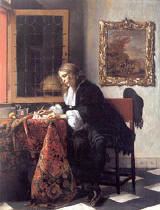
(c) Young man Writing a Letter
Gabriel Metsu
c. 1662-1665, 52.5 x 40.2 cm.
National Gallery of Ireland, Dublin
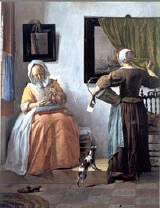
(d) Young Woman Reading a Letter
Gabriel Metsu
c. 1662-1665, 52.5 x 40.2 cm.
National Gallery of Ireland, Dublin
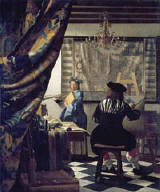
(k) The Art of Painting
Johannes Vermeer
c. 1662- 1668 , 120 X 100 cm.
Kunsthistorisches Museum, Vienna
